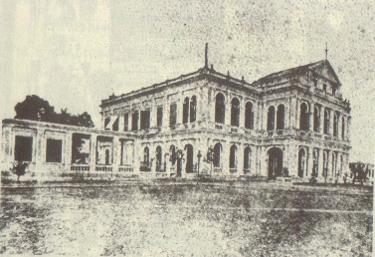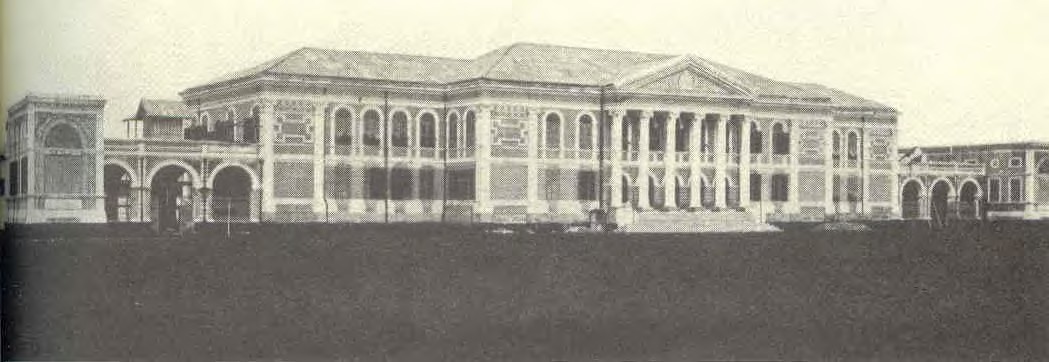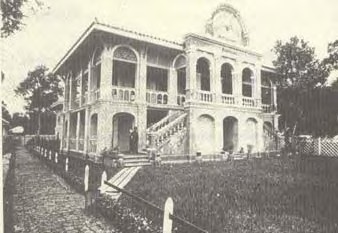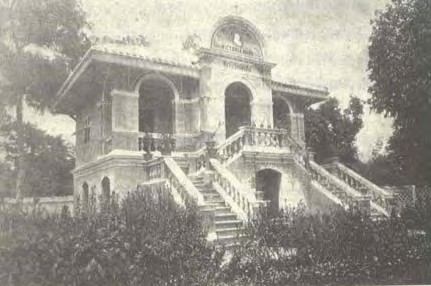This page reprints an appendix from a paper written by Alisa Dechar, "PRELIMINARY STUDY OF THE EXISTING CONDITIONS OF THE CUSTOMS HOUSE FOR ADAPTIVE REUSE". A complete citation is at the end.
This page contains a list, and some photos, of buildings designed/built by Grassi Brothers.
<<<<<<<<<<<<<< >>>>>>>>>>>>>>
Appendix B : Biography of Mr. Joachim Grassi [1]
Mr.Joachim Grassi was born on December 26, 1837 at the Capodistria in the Trieste Seaport where there was the part of the Adriatic seashore in the Austro- Hungarian Empire. He had been worked in Shainghai for a while before going to Siam in 1870. At the early time when he arrived in Siam, he worked for the Bonneville, the French timber company in Bangkok. Until 1873, the timber business stagnated therefore he started to be the building contractor.
Mr.Grassi came to Siam during the reign of King Rama V, that was the time of the development of the country and there was also the time of the Western influence in South East Asia. Hence, most of several things in Bangkok had been changed particularly the architecture. At that time, King Rama V appreciated the western technology thus there were a lot of foreigners in Siam government. Mr. Grassi was one of the important architects who had done a lot of works for the King.
The first design of Mr.Grassi is the Concordia Club and at the same time he also designed the residence for the Siam aristocrats (before 1875)2 such as Chaophraya Banuwongsa Mahakosathipbadee (Toum Bunnag) and Somdej Chaophraya Barommaha Srisuriyawongsa (Choung Bunnag). The aforementioned works were very interesting for people to admire, therefore, he was the popular architect who designed several famous buildings for King Rama V and the Siam government. According to his reputation, he established the construction contract company with his brothers “Grassi Brothers & Co.” It was the biggest construction contract company at that time.
The style of his work was influenced by the famous architect in Europe; Andria Palladio. He was the great architect of the Western world who was created the architectural style named as ‘Palladian’. The Palladian style combines the main characters of the Renaissance and the Ancient Rome together. At the same time, this style is also emphasized on the symmetry of the building.
Mr.Grassi served under the Siam Government for ten years and his last work was the design of the Phra Chulajomklao Fort. In 1889, King Rama V commanded to establish the Public Works Department due to the political policy; therefore this institute directly affected his work. At the same time, he also had some conflicts with Siam Government. Therefore, in 1893, Mr.Grassi defected from Siam to the Trieste Seaport. He passed away at the Trieste on September 20, 1904.
1872-1876 Bang Pa-in Palace
1875-1881 Burabhabhirom Palace
1875-1882 Prince Saisanidwongsa’s Palace
1873-1875 Nivesthammaprawat Temple
1876 Sapanthan Palace
1876-1877 Prince Sawasdisophon’s Palace
~ 1877 Thapra Palace
Prince Ratchasakdisamosorn’s Palace
1878-1883 New palace at Pathumwan district
1881 The Justice Palace (opposite to SanamLuang)
1882 The Royal barracks
1883 The Cavalry barracks
Saint Joseph Church at Ayudhaya Province
Bell Tower of Conception Church
1884-1887 The Customs House
1887 The Assumption College
1888 Saowapak Building & Victoria Building at Siriraj Hospital
1889 The New Prison
Phra Chulachomklao Fort

Figure156: Bhurababhirom Palace

Figure157: Pannarai Building,Thaphra Palace

Figure158: TheJusticePalace

Figure159: New palace at Pathumwan district

Figure 160 : Saowapak Building, Siriraj Hospital

Figure161: Victoria Building, Siriraj Hospital
[1] Peerasri Bhowatong 2005, Foreigners Engineers in Siam; the reign of King Rama V, Chulalongkorn University Bangkok
[2] SranTongpan 1998, “Grassi and Western Architecture in Siam”, Muang Boran Issue 24, Vol.2, MuangBoran, Bangkok
Source: PRELIMINARY STUDY OF THE EXISTING CONDITIONS OF THE CUSTOMS HOUSE FOR ADAPTIVE REUSE
Alisa Dechar
A Research Project Submitted in Partial Fulfillment of the Requirement for the Degree MASTER OF ARTS Architectural Heritage Management and Tourism (International Program) Graduate School, SILPAKORN UNIVERSITY, 2005. ISBN 974-11-6487-4